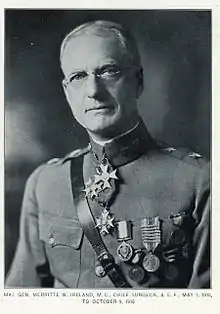Merritte W. Ireland
Merritte Weber Ireland (May 31, 1867 – July 5, 1952) was the 23rd U.S. Army Surgeon General, serving in that capacity from October 4, 1918, to May 31, 1931.
Merritte Weber Ireland | |
|---|---|
 Maj. General Ireland in 1918 | |
| Born | May 31, 1867 Columbia City, Indiana |
| Died | July 5, 1952 (aged 85) Washington, D.C. |
| Allegiance | |
| Service/ | |
| Years of service | 1891–1931 |
| Rank | |
| Commands held | Surgeon General of the US Army |
| Battles/wars | Spanish–American War Philippine–American War Pancho Villa Expedition World War I |
| Awards | Distinguished Service Medal |
Early life and education
Ireland was born on May 31, 1867, in Columbia City, Indiana,[1] a town in the upper end of the Wabash Valley in Whitley County, Indiana. His father, Dr. Martin Ireland, was born in Chillicothe, Ohio, and his mother, whose maiden name was Sarah Fellers, came from Waynesboro, Virginia.
He graduated from the Detroit College of Medicine, receiving an M.D. degree in 1890.[1] The following year was spent in Jefferson Medical College where again he earned an M.D. degree in 1891.
Military career
He served as a surgeon with the 45th U.S. Volunteer Infantry in 1899 and honorably discharged in 1901.[1]
In 1903, he was commissioned as a surgeon into the Medical Corps.[1]
During World War I, Ireland served as chief surgeon of the American Expeditionary Forces.[2] He departed France in October 1918 and was succeeded by his deputy, Walter McCaw.[2] He was awarded the Army Distinguished Service Medal for his service during the war, with the medal's citation reading:
The President of the United States of America, authorized by Act of Congress, July 9, 1918, takes pleasure in presenting the Army Distinguished Service Medal to Major General Merritte Weber Ireland, United States Army, for exceptionally meritorious and distinguished services to the Government of the United States, in a duty of great responsibility during World War I. As Chief Surgeon of the American Expeditionary Forces, General Ireland supervised and perfected the organization of the Medical Department in France, and to his excellent judgment, untiring efforts, and high professional attainments are largely due the splendid efficiency with which the sick and wounded of the American Army have been cared for.[3]
He served as Surgeon General from October 4, 1918, to May 31, 1931.[1]
Death and legacy
Ireland died on July 5, 1952.[1]
Legacy
- Ireland's papers are held at the National Library of Medicine.[4]
- Ireland Army Community Hospital, located at Fort Knox, Kentucky, was built in 1957 and named in his honor.[5]
Military awards
Major General Ireland's ribbon bar:
Dates of rank
| Insignia | Rank | Component | Date |
|---|---|---|---|
| Assistant Surgeon | Regular Army | 4 May 1891 | |
| Assistant Surgeon | Regular Army | 4 May 1896 | |
| Surgeon | Volunteers | 17 August 1899 (Honorably discharged from Volunteers on 30 June 1901.) | |
| Major | Regular Army | 3 August 1903 | |
| Lieutenant Colonel | Regular Army | 1 May 1911 | |
| Colonel | Regular Army | 15 May 1917 | |
| Brigadier General | National Army | 1 May 1918 | |
| Major General | Regular Army | 8 August 1918 | |
| Major General | Retired List | 31 May 1931 |
Source: Army Register, 1932[6]
References
- Davis, Henry Blaine Jr. (1998). Generals in Khaki. Pentland Press, Inc. pp. 194–195. ISBN 1571970886. OCLC 40298151.
- Phalen, James M. (October 1942). "Brigadier General Walter D. McCaw (1863-1939)". Army Medical Bulletin. Washington, DC: Office of the U.S. Surgeon General, U.S. Department of War. pp. 135–137 – via Google Books.
- "Valor awards for Merritte Weber Ireland". Military Times.
- "Merritte Weber Ireland Papers 1911–1952". National Library of Medicine.
- "History of Ireland Army Community Hospital". Ireland Army Community Hospital. United States Army. Archived from the original on 15 June 2014. Retrieved 14 June 2014.
- The Adjutant General's Office, War Department (1932). Official Army Register for 1932 (PDF). Washington, D.C.: Government Printing Office. p. 852. Retrieved September 25, 2020.
![]() This article incorporates public domain material from the United States Army.
This article incorporates public domain material from the United States Army.